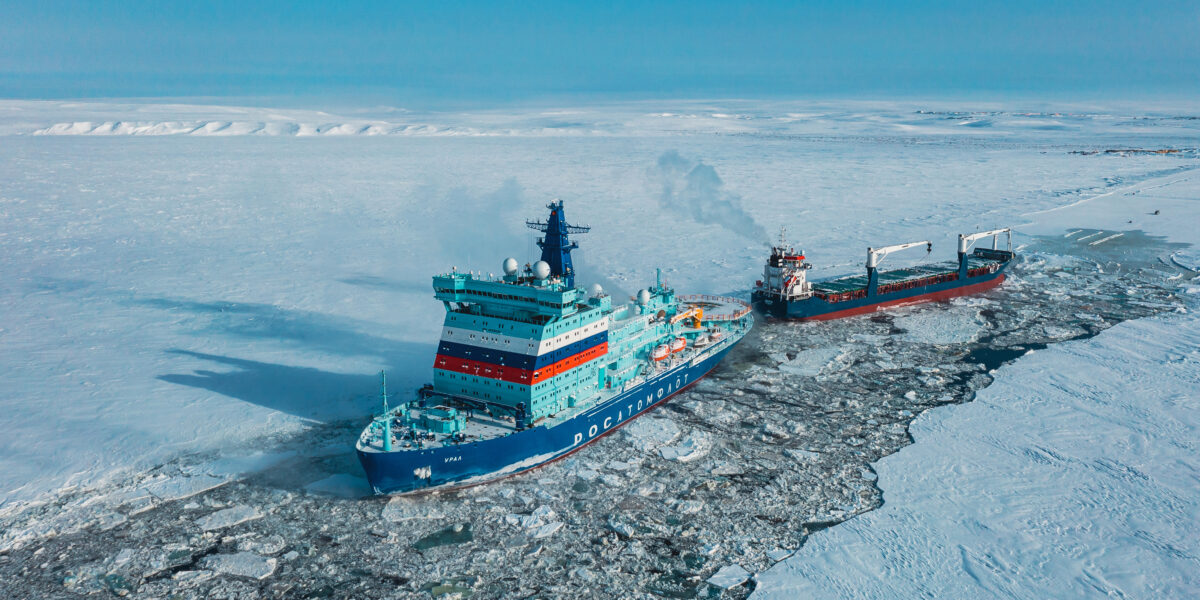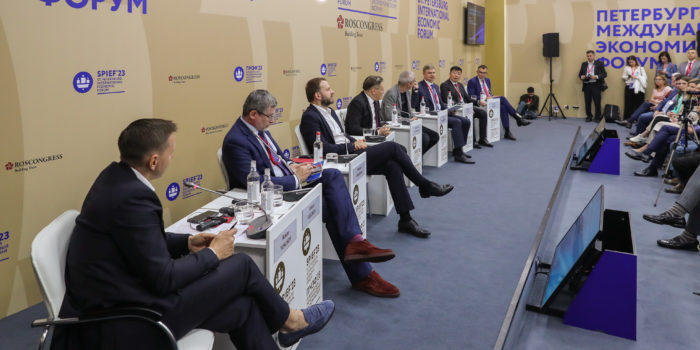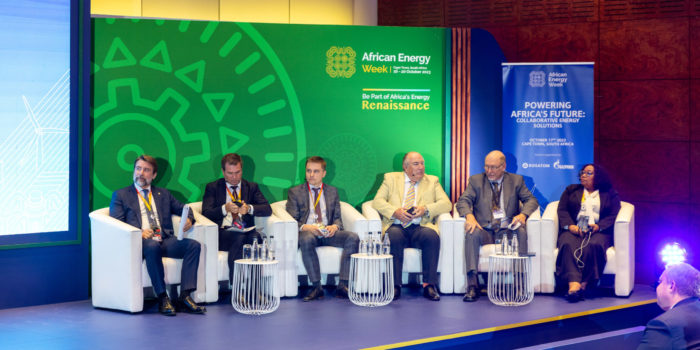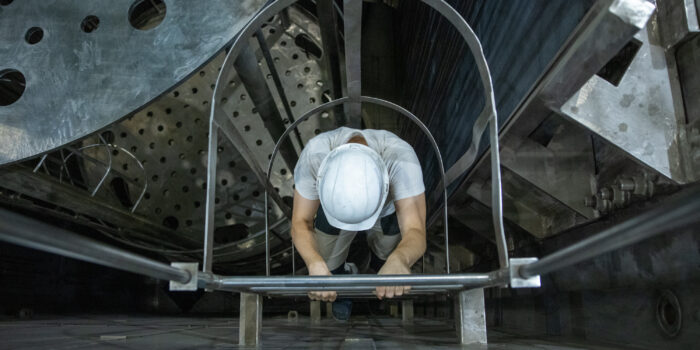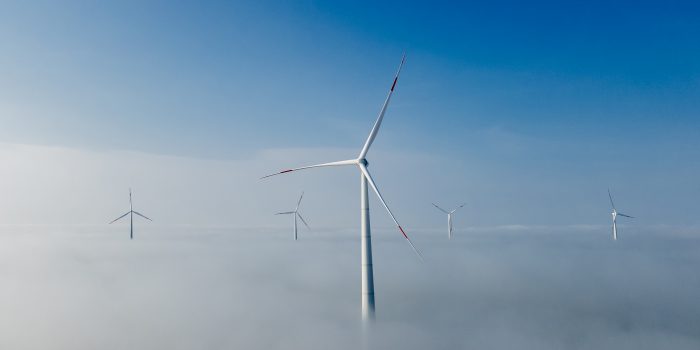The Northern Sea Route (the NSR). Overview
The Northern Sea Route (the NSR) is the shortest shipping route connecting the western Eurasia with the Asia-Pacific region. Historically, the NSR has been a national transportation artery of the Russian Federation.
The Northern Sea Route includes the waters along the northern shoreline of the Russian Federation, inland sea waters, territorial waters, the adjacent area and the exclusive economic zone of the country. Its eastern boundary is defined by the parallel of latitude at Cape Dezhnev in the Bering Sea while its western boundary is defined by the meridian of longitude at Cape Zhelaniye, which continues to the Novaya Zemlya archipelago. The route runs along the eastern coast of Novaya Zemlya and the western coasts of the Matochkin Strait, the Kara Strait, and the Yugorski Strait.
The length of the Northern Sea Route is about 5,600 kilometers.
The NSR traverses the seas of the Arctic Ocean, including the Kara Sea, Laptev Sea, East Siberian Sea, and Chukchi Sea.
The ports of the Arctic and the major rivers of Siberia provides services for the Northern Sea Route. Currently, there are six major seaports along the route in the Arctic region of the Russian Federation. These include Sabetta, Dikson, Dudinka, Khatanga, Tiksi, and Pevek ports.
The first reference to the Northern Sea Route dates back to 1525 when Russian envoy Dmitry Gerasimov came up with an idea of arranging a shipping route through the Arctic Ocean, which opened up the possibility for maritime communication between Russia and China. That year marked the beginning of the Russian history of the route development. In 2025, the NSR is celebrating its 500th anniversary.
The Northern Sea Route has a number of advantages
- This route is shorter than the conventional southern route. Traveling between Asia and most European ports via the Northern Sea Route takes 30%-40% less time than traveling via the Suez Canal.
- Given the global goal of reducing carbon emissions from maritime transportation, shorter routes offer a way to minimize the man-induced impact on the world’s oceans. Furthermore, ships navigate through the Arctic seas with the assistance of nuclear icebreakers, which emit virtually zero carbon dioxide.
- Due to its shorter distance and lack of queues at its entry point, the Northern Sea Route ensures significantly reduced travel time, which helps optimize the cost of transporting goods and increase the efficiency of the global supply chain.
- Voyages along the NSR involve no risk of piracy, which makes the NSR a safe and efficient addition to existing shipping routes.
In 2018, Rosatom was appointed as the NSR infrastructure operator. Rosatom’s scope in the NSR development plan until 2035 includes the creation of the necessary infrastructure, ranging from the construction of icebreakers, hydrographic and rescue vessels to the construction of ports and launch of digital services to improve navigation efficiency.
Nuclear icebreaker fleet
The waters of the Arctic Ocean are icebound for most of the year. Icebreaking assistance ensures safe navigation along the Northern Sea Route. Russia is the only country in the world with a fleet of nuclear icebreakers, and Atomflot, a company of Rosatom, operates the fleet.
Nuclear icebreakers’ advantages:
- Nuclear icebreakers are powerful. They can break ice up to three meters thick.
- Nuclear icebreakers are self-sustaining. A nuclear power unit ensures that the nuclear ship can operate for up to 7 years without refueling.
- Nuclear icebreakers are eco-friendly. Their operation generates virtually no carbon dioxide emissions.
Today, the icebreaker fleet of Atomflot (a company of Rosatom) includes eight nuclear icebreakers. These are 50 Let Pobedy, Vaigach, Yamal and Taimyr, the universal nuclear icebreaker Arktika (project 22220), universal nuclear icebreaker Sibir (project 22220), universal nuclear icebreaker Ural (project 22220) and universal nuclear icebreaker Yakutia (project 22220).
Currently under construction:
- The 5th universal nuclear icebreaker Chukotka (project 22220) with a shaft power of 60 MW and Icebreaker 9 ice class, under construction at Baltic Shipyard JSC, launched in 2024.
- The 6th universal nuclear icebreaker Leningrad (project 22220) with a shaft power of 60 MW and Icebreaker 9 ice class, under construction at Baltic Shipyard JSC.
- The nuclear icebreaker Rossiya (project 10510) with a shaft power of 120 MW, Icebreaker 9 ice class, under construction at Zvezda Shipyard.
- A contract has been signed to construct the 7th universal nuclear icebreaker Stalingrad (project 22220) with a shaft power of 60 MW, Icebreaker 9 ice class; construction at Baltic Shipyard JSC.
In December 2024, the keel laying ceremony was held for a multi-functional nuclear service vessel of project 22770. This vessel is designed to refuel the nuclear power units of project 22220 nuclear icebreakers, as well as of the world’s most powerful nuclear icebreaker Rossiya in the future. The multifunctional nuclear service vessel will be used to load fresh nuclear fuel onto the icebreakers, unload spent fuel and store spent nuclear fuel assemblies until they are shipped for reprocessing.
Dynamics of the NSR cargo traffic
The NSR cargo traffic has been increasing rapidly: 2012 – 3.87 million tons, 2013 – 3.93 million tons, 2014 – 3.982 million tons, 2015 – 5.392 million tons, 2016 – 7.265 million tons, 2017 – 10.7 million tons, 2018 – 19.7 million tons, 2019 – 31.5 million tons, 2020 – 32.978, 2021 г – 34.867 million tons, 2022 – 34.117 million tons, 2023 – 36.254 million tons, 2024 – 37.89 million tons.
In 2024, the volume of cargo transported along the Northern Sea Route reached an all-time high, surpassing the previous year’s record by over 1.6 million tons. The total volume of cargo transported in 2024 was approximately 37.9 million tons.
The year 2024 saw a record number of transit voyages, with a total of 92, and a record-breaking volume of transit cargo exceeding 3 million tons. This represents an almost 1.5-fold increase compared to 2023.
Eco-friendliness
Environmental protection along with the increased maritime traffic in the Arctic region is essential for its development. This can be achieved through a rational approach to economic activities, which is exactly the approach taken by Rosatom.
The implementation of a comprehensive environmental monitoring program for the Northern Sea Route is an important step taken by Rosatom. This program was developed jointly with the Center for Marine Research at Moscow State University and launched in 2021. The project is ongoing in 2025.
The comprehensive environmental monitoring program includes collecting marine samples, conducting atmospheric studies, laboratory investigation of selected materials, analyzing data from the digital satellite monitoring system. The findings show no deviations in the environmental conditions from the average environmental levels at the time of the monitoring.
The NSR environmental monitoring program follows the latest Russian and international requirements as well as the best Russian and international practices in the field of environmental research and protection. An international group of experts is actively participating in the program development and related discussions. Representatives from leading scientific institutions of Russia, Norway, Finland, France, Iceland, the UK, China, India, Egypt, Malaysia, Turkey, Japan, and the USA have been involved in this project for four years.
Representatives of the expert community gave the program their high opinion. It was presented at major international events, including Arctic Frontiers, the World Conference on Marine Biodiversity in Malaysia, the International Symposium on the Okhotsk Sea and Polar Oceans in Japan, COP28 and COP29, the St. Petersburg International Economic Forum, the International Arctic Forum, and the Eastern Economic Forum.
International cooperation
Russia places a high priority on building mutually beneficial partnerships with countries that adopt a constructive policy towards the Russian Federation and show their interest in international cooperation in the Arctic region.
Rosatom is actively working to develop and strengthen its international partnerships, creating a favorable environment for the growth of multifaceted collaboration on the Northern Sea Route from the increase in cargo traffic to the development of the infrastructure and scientific cooperation on issues of ecology and sustainable Arctic shipping.
International businesses are showing interest in the NSR transit potential. Asian and Middle Eastern companies view container transit via the NSR as a sustainable and stable alternative route.
Milestones of 2024
- The 6th universal nuclear icebreaker Leningrad of project 22220 laid down.
- The nuclear icebreaker Chukotka launched.
- The state flag raised aboard the nuclear icebreaker Yakutiya.
- The multifunctional nuclear service vessel Vladimir Vorobiev was laid down at the site of Baltic Shipyard JSC.
- At the St. Petersburg International Economic Forum, a company of Rosatom and a Chinese shipping company signed an agreement of intent to launch a year-round container service between ports in Russia and China, utilizing the Northern Sea Route.
- Rosatom, the Ministry for the Development of the Russian Far East and the Government of the Chukotka Autonomous Okrug signed an agreement on the joint implementation of a pilot project to create a single marine operator for northern deliveries.
- The multimodal logistics route, “Express NSR N1”, connecting the ports of Shanghai and Ningbo in China with Arkhangelsk via the Northern Sea Route opened. Cargo is further transported from Arkhangelsk to Moscow and St. Petersburg by train.
- For the first time, cargo was shipped from Shanghai to Belarus via the Northern Sea Route.
- The largest ever container ship was successfully assisted along the Northern Sea Route. The Chinese ice class vessel ICE 1 measuring 294 meters in length and having a container capacity of 4,843 TEUs departed from the port of St. Petersburg and headed for the Chinese port city of Qingdao.
- The first Sub-commission on Cooperation on the Northern Sea Route (NSR) of the Russian-Chinese Commission for the Preparation of Regular Meetings of Heads of Government took place. The Sub-commission was co-chaired by Alexey Likhachev, Director General of Rosatom, on the Russian side, and Liu Wei, the Minister of Transport of the People’s Republic of China, on the Chinese side.
- Representatives from Rosatom took part in the first meeting of the Russian-Indian working group on collaboration on the Northern Sea Route. In New Delhi, they discussed the prospect of training Indian sailors in polar navigation and developing joint projects in Arctic shipbuilding.
- The program for environmental monitoring of the Northern Sea Route was presented at the Arctic Pavilion of the Northern Forum international organization within the framework of COP29. This program is being implemented by the Center for Marine Research at Moscow State University by Rosatom’s initiative.
- The first international voyage of Rosatom’s scientific and educational expedition “Icebreaker of Knowledge” took place in August 2024 (with the participation of experts and schoolchildren from Russia, Uzbekistan, Belarus, Bangladesh, Cameroon, Tunisia, Armenia, Kazakhstan, Kyrgyzstan, Mongolia, India, China, South Africa, and Hungary).

